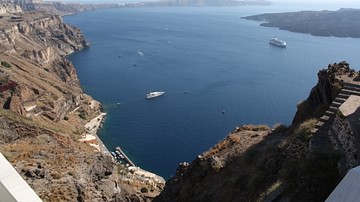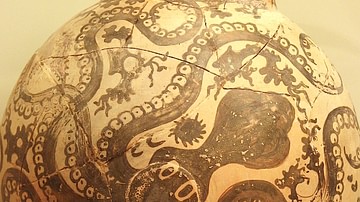The Bronze Age frescoes from Akrotiri on the Aegean island of Thera (modern-day Santorini) provide some of the most famous images from the ancient Greek world. Sometime between 1650 and 1550 BCE Thera suffered a devastating earthquake which destroyed the town, and this catastrophe was soon followed by a volcanic eruption which covered the settlement of Akrotiri in metres-thick layers of pumice and volcanic ash. As a result, the vibrant frescoes which were on the walls of almost all buildings in the town have been remarkably well preserved. When the first systematic excavations began in 1967 CE, the secrets and wonders of this lost ancient city were finally re-discovered and once again admired by the human eye.
Method & Materials
The vast majority of frescoes belonged to the second story of buildings, and their presence in buildings of all types suggests that frescoes were not restricted to a rich elite but were enjoyed by all classes of society. The interior walls were covered with a layer of smooth lime plaster and then painted, either when the plaster was fresh (fresco) or dry (secco or tempera). Some of the geometric designs, especially spirals, show signs of mechanical devices to achieve greater accuracy. Similarly, in order to portray people accurately, figures employed a grid system which was proportionally adjusted depending on the age or dimension of the figure. Paints were derived from minerals to provide strong colours such as red, orange, black, blue, purple, and white, and organic material was used as a fixative.
Subjects
In many cases all four walls were decorated to create a panoramic scene which sometimes transports the viewer out of the confines of the room. From 2000 BCE until the fateful earthquake and eruption, Thera had established itself as a thriving Mediterranean trading centre with links to the peoples of Crete, the Cyclades, mainland Greece, and Egypt, and this is reflected in the subject of some of the frescoes and in their style which displays many similarities to frescoes on Minoan Crete and in Egypt.
The frescoes display a clear love of the sea and the natural world with seascapes, animals, fish, and plants being popular subjects. There are naturalistic representations of bulls, goats, antelopes, monkeys, wild-cats, ducks, and swallows, and there are also mythological creatures, notably griffins. Geometrical and abstract shapes, especially curves and spirals, were also a common theme as are scenes of everyday life such as religious ceremonies and the collecting of crocuses and saffron. These latter scenes are also invaluable for historians to note such items as Bronze Age clothes, jewellery, hairstyles, armour, weapons, architecture, landscapes, and crafts such as ship-building.
Dr. N. Marinatos summarises the purpose of frescoes at Akrotiri as much more than works of mere aesthetic value; she convincingly argues that the frescoes had a specific connection to the function of the room in which they were painted:
For a Minoan or Theran, a painting represented part of his tradition which was comprehensible and even predictable. It can be said that art was a representation of the collective values of the society of which the viewer was a member. Thus, the relationship between art and viewer was intimate and the function of the painting important...the themes centred around religious experiences, although these could be indirect as well as direct. Political portraiture seems to be totally absent. (33)

The Boxers Fresco
This fresco comes from Room B1 of Building Beta and depicts two youths boxing, perhaps a ritual sport rather than a competitive match. The other three walls of this room have a much larger fresco depicting antelopes. That the boxers are boys is suggested by the red colouring, a typical convention when showing males. They wear only a belt and loincloth with a boxing glove only on the right hand. Their hair has long tresses with shaved parts - a sign of youth. The boy on the left wears a surprising amount of jewellery: necklace, earrings, bracelets, and anklets, whilst his opponent has none. Marinatos suggests that the playful competition of strength mirrors the competing antelopes who also seem to be facing off on the other walls of the room. (National Archaeological Museum, Athens).
The Fisherman Fresco
This fresco is from the north-eastern corner of Room 5 in the West House. It is one of the best preserved frescoes from Akrotiri and shows a male figure holding a bunch of fish in each hand tied together with yellow string. A very similar fresco adorned the adjoining wall. Both figures are nude and have partially shaved heads; both points strongly suggest these figures are youths performing a religious ritual. This religious connection is reinforced by the presence of recesses in the walls of Room 5 and ritual pottery vessels in the adjoining corridor. Even more convincing evidence that the figures are giving an offering of fish is that both figures are walking in the direction of the north-west corner of the room precisely where an offering table was found by archaeologists. (National Archaeological Museum, Athens).
The Ladies Fresco
This fresco is in fact two separate pieces, each depicting a woman, and they come from Room 2 of the House of the Ladies and were positioned in the other half of the room in which there was also the Papyrus Fresco (see below). The women are wearing coloured Minoan robes with kilts and jackets which leaves the breasts exposed in typical Minoan fashion. The women each wear earrings and a necklace and they both have long hair and wear makeup. All of these details suggest women of high status involved in some sort of religious activity or festival. Above the women is a representation of a starry sky. There is a third woman, next to the stooping figure who may be helping her dress but only fragments of an arm and dress survive. (Museum of Prehistoric Thera, Santorini).
The Lilies Fresco
This fresco, also known as the Spring Fresco, comes from three walls of Room 2, a ground floor room from Building Delta, and depicts either papyrus or lilies growing amongst colourful volcanic rocks with swallows flying between the flowers. The lilies seem to be swaying in a gentle breeze and the flowers are depicted in various stages of growth from bud to full bloom. The fresco ignores the three plains of the walls to create a convincing surround effect which captures the vibrancy and regeneration of springtime. (National Archaeological Museum, Athens).
The Monkey Fresco
This fresco depicting blue monkeys survives only in fragments and comes from Room B6. In the scene the monkeys are climbing rocks in an effort to escape the two dogs chasing them. Monkeys appear elsewhere in Theran and Minoan art, and they are often depicted as attendants to priestesses or near sacred altars. A fossilized monkey skull has been found on the island suggesting the possibility that they were present on Thera. (Museum of Prehistoric Thera, Santorini).
The Papyrus Fresco
This fresco comes from the Room of the Ladies from the house of the same name. The papyrus flowers are shown in groups of three and cover three walls. They are not accurate in their depiction, perhaps deliberately so, but the iconography is Egyptian in style and, in any case, papyrus was not indigenous to Thera. Beneath the plants may be a river, a common association in both Minoan and Egyptian art. The discovery of ritual vessels within four sealed containers under the floor of the room suggests that it was used as a shrine. (Museum of Prehistoric Thera, Santorini).

The Ship Fresco
This 6 metre fresco of a procession or escort of ships in miniature is from the south-west wall of Room 5 in the West House. Eight large ships and three smaller vessels, all powered by oarsmen, travel from one port to another with centre stage taken by the flagship of the fleet. The town on the right is more sophisticated (both in architecture and the inhabitants' clothes) and is identified by Marinatos as Akrotiri, whilst the flora and fauna of the town on the left identify it as Aegean, possibly another, more provincial town, on the island. In addition, the propulsion of the ships using oars suggests the two towns were not far apart. The scene may be a representation of a seasonal maritime festival or even a scene from a lost epic poem. The ships are decorated with flowers, butterflies, swallows, and symbols of nature which all suggest a religious festival as more likely. Dolphins very similar to those from Knossos leap between the ships and the buildings; flora and fauna in each port are drawn in great detail, as are the long robes of the ship passengers, which suggest they are of high social status and, once again, participating in an important religious festival. (National Archaeological Museum, Athens).










